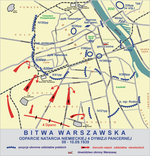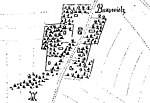September Barricade Monument
1979 establishments in Poland1979 sculpturesBrutalist architectureBuildings and structures completed in 1979Concrete sculptures ... and 3 more
OchotaOutdoor sculptures in WarsawWorld War II monuments and memorials in Warsaw

The September Barricade Monument (Polish: Pomnik Barykada Września) is a brutalist mounument in Warsaw, Poland. It is located in the district of Ochota, at Grójecka Street, near the intersection with Opaczewska Street. The monument commemorates a barricade that was constructed by the Polish Armed Forces during the Siege of Warsaw, and used between 8 and 27 September 1939. It consists of three large concrete sculptures, depicting numerals of dates 8-IX (8 September), the day the barricade was erected, 1939, the year of the siege, and 27-IX (27 September), the day the city capitulated. It was designed by Julian Pałka, and unveiled on 12 September 1979.
Excerpt from the Wikipedia article September Barricade Monument (License: CC BY-SA 3.0, Authors, Images).September Barricade Monument
Grójecka, Warsaw Ochota
Geographical coordinates (GPS) Address External links Nearby Places Show on map
Geographical coordinates (GPS)
| Latitude | Longitude |
|---|---|
| N 52.210259 ° | E 20.975908 ° |
Address
1939 (Pomnik Barykada Września)
Grójecka
02-101 Warsaw, Ochota
Masovian Voivodeship, Poland
Open on Google Maps











